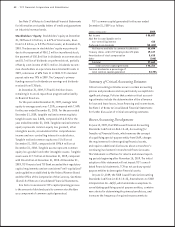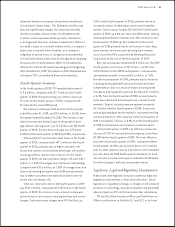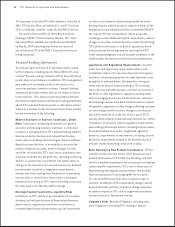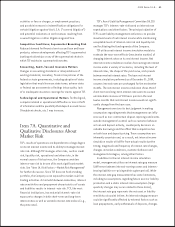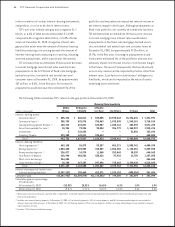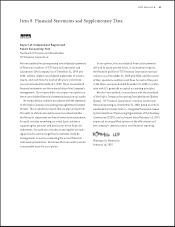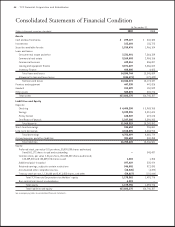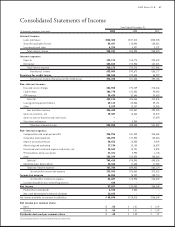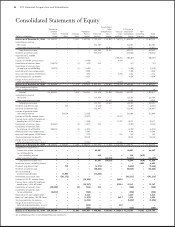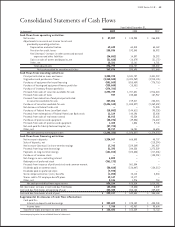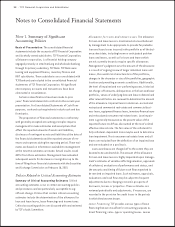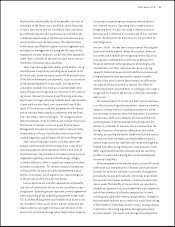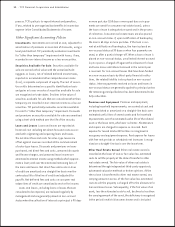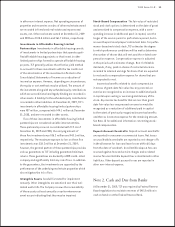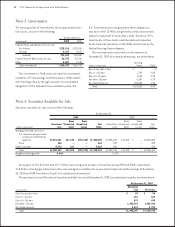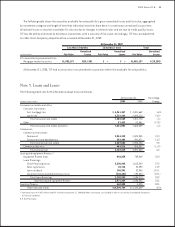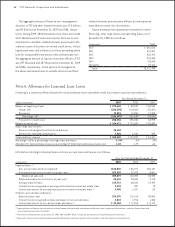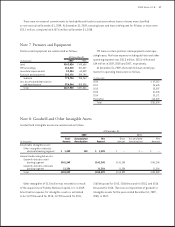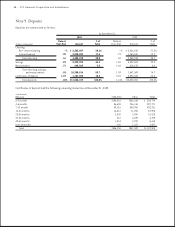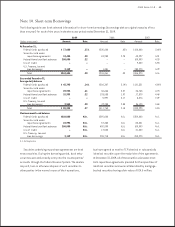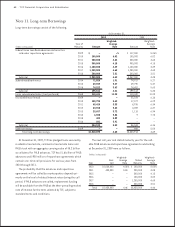TCF Bank 2009 Annual Report Download - page 66
Download and view the complete annual report
Please find page 66 of the 2009 TCF Bank annual report below. You can navigate through the pages in the report by either clicking on the pages listed below, or by using the keyword search tool below to find specific information within the annual report.
50 : TCF Financial Corporation and Subsidiaries
Note 1. Summary of Significant
Accounting Policies
The consolidated nancial
statements include the accounts of TCF Financial Corporation
and its wholly owned subsidiaries. TCF Financial Corporation,
a Delaware corporation, is a nancial holding company
engaged primarily in retail banking and wholesale banking
through its primary subsidiary, TCF Bank. TCF Bank owns
leasing and equipment nance, inventory nance and
REIT subsidiaries. These subsidiaries are consolidated with
TCF Bank and are included in the consolidated nancial
statements of TCF Financial Corporation. All signicant
intercompany accounts and transactions have been
eliminated in consolidation.
Certain reclassications have been made to prior
years’ nancial statements to conform to the current year
presentation. For Consolidated Statements of Cash Flows
purposes, cash and cash equivalents include cash and due
from banks.
The preparation of nancial statements in conformity
with generally accepted accounting principles requires
management to make estimates and assumptions that
affect the reported amounts of assets and liabilities,
disclosure of contingent assets and liabilities at the date of
the nancial statements and the reported amount of rev-
enues and expenses during the reporting period. These esti-
mates are based on information available to management
at the time the estimates are made. Actual results could
differ from those estimates. Management has evaluated
subsequent events for disclosure or recognition up to the
time of ling these nancial statements with the Securities
and Exchange Commission on February 16, 2010.
Policies Related to Critical Accounting Estimates
Critical
accounting estimates occur in certain accounting policies
and procedures and are particularly susceptible to sig-
nicant change. Policies that contain critical accounting
estimates include the determination of the allowance for
loan and lease losses, lease nancings and income taxes.
Critical accounting policies are discussed with and reviewed
by TCF’s Audit Committee.
Allowance for Loan and Lease Losses The allowance
for loan and lease losses is maintained at a level believed
by management to be appropriate to provide for probable
loan and lease losses incurred in the portfolio as of the bal-
ance sheet date, including known or anticipated problem
loans and leases, as well as for loans and leases which
are not currently known to require specic allowances.
Management’s judgment as to the amount of the allowance
is a result of ongoing review of larger individual loans and
leases, the overall risk characteristics of the portfolios,
changes in the character or size of the portfolios, geographic
location and prevailing economic conditions. Additionally,
the level of impaired and non-performing assets, historical
net charge-off amounts, delinquencies in the loan and lease
portfolios, values of underlying loan and lease collateral and
other relevant factors are reviewed to determine the amount
of the allowance. Impaired loans include non-accrual and
restructured commercial real estate and commercial busi-
ness loans, equipment nance loans, inventory nance loans
and restructured consumer real estate loans. Loan impair-
ment is generally measured as the present value of the
expected future cash ows discounted at the loan’s initial
effective interest rate. The fair value of the collateral for
fully collateral-dependent loans may be used to determine
loan impairment. Most consumer real estate loans and all
leases are excluded from the denition of an impaired loan
and are evaluated on a pool basis.
Loans and leases are charged off to the extent they are
deemed to be uncollectible. The amount of the allowance
for loan and lease losses is highly dependent upon manage-
ment’s estimates of variables affecting valuation, appraisals
of collateral, evaluations of performance and status, and
the amounts and timing of future cash ows expected to
be received on impaired loans. Such estimates, appraisals,
evaluations and cash ows may be subject to frequent
adjustments due to changing economic prospects of
borrowers, lessees or properties. These estimates are
reviewed periodically and adjustments, if necessary, are
recorded in the provision for credit losses in the periods
in which they become known.
Lease Financing TCF provides various types of lease
nancing that are classied for accounting purposes as
direct nancing, sales-type or operating leases. Leases
Notes to Consolidated Financial Statements


